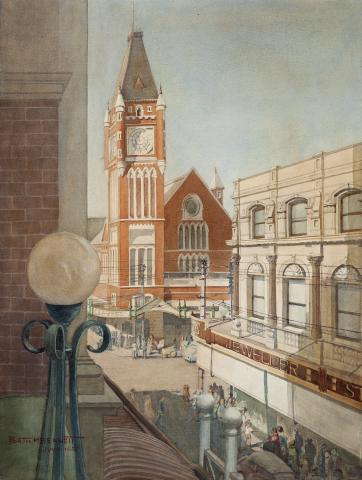JUNE (PERTH TOWN HALL), 1951
PORTIA BENNETT
watercolour on paper
81.0 x 61.0 cm
signed, dated and inscribed lower left: PORTIA M BENNETT / JUNE 1951
Private collection, Perth, acquired directly from the artist c.1965
Perth Society of Artists: Autumn Exhibition, Skinner Galleries, Perth, 5 – 18 May 1959, cat. 42 (as ‘June’)
Perth Town Hall, 1935, watercolour on paper, 59.0 x 42.0 cm, collection of the Art Gallery of Western Australia, illus. in Gooding, J., Western Australian Art and Artists 1900 – 1950, Art Gallery of Western Australia, Perth, 1987, p. 55
Lawson Flats, Riverside Drive, c.1936, 37.0 x 27.0 cm, watercolour and pencil, The University of Western Australia Art, Perth
Hotel Adelphi, Perth, 1948, watercolour and pencil, 56.5 x 54.0 cm, The University of Western Australia Art Collection, Perth
Portia Bennett belongs to that extraordinary generation of women artists who helped progress modernism in Australia through their art, design and architecture. These include Grace Crowley, Dorritt Black, and Anne Dangar, all co-students of Bennett’s – when they attended the Julian Ashton Art School in Sydney. Previously she studied for two years with Antonio Dattilo Rubbo at the Royal Art Society School in Sydney, alongside Roland Wakelin and Roy de Maistre. Even then, Bennett made an impact, establishing ‘a youthful reputation amongst her now famous co-students with her dark, flat-planed images of Sydney streets. In 1924… she held a well-received exhibition with Rah Fizelle. On her marriage, Bennett had been persuaded of the unsuitability of her art ambitions and abandoned her art practice. The discovery (in Perth) that her old friends from Julian Ashton’s were continuing to paint, without conflict or scandal in a conservative society, permitted her to return to her former occupation.’ 1
These old friends were Muriel Southern and Florence Hall who had a studio complex in the CBD with their friend Margaret Johnson. Together, the four women held an exhibition in 1933 at Newspaper House in Perth, and soon became foundation members of the Perth Society of Artists. For a painter who had originally harbored the wish to be an architect, having a base within the city from which to operate allowed Bennett to explore the changing built identity of the town. The word town is used advisedly as Perth was just as affected by the travails of the Depression and was already of limited size, but an unexpected expansion of gold mining in the mid-1930s in Kalgoorlie and Coolgardie led to a renewed sense of optimistic prosperity. In response, a series of moderne-style buildings were erected, including Lawson Flats and the wonderful Adelphi Hotel. Unsurprisingly, these also attracted the eye of Bennett and her watercolour renditions of these are rightly prized by their institutional owner. Much has been written on Bennett’s aesthetic as being a West Australian version of Melbourne’s Clarice Beckett through her deliberate inclusion of cars, tram wires and power poles to indicate modernity itself. However, this to a degree is a revisionist exaggeration. Bennett was fascinated by all the design harmonies of the built environment and the effects of light upon it. Signs and power lines were recorded simply because they were there and it was true to her artistic judgment.
The Perth Town Hall, which opened in 1870, was the last civic building in Australia to use convict labour. It was a favourite subject for Bennett and she returned to it at different times in her career. In her familiar manner, the artist locates herself on an upper balcony across the road which gives a raised, almost birds-eye aspect to her subject. After many years of patient observation, Bennett noted that 'the Town Hall is nothing to look at until mid winter, about June, when the sun strikes the corner of Royal Arcade and reflects onto the Hall, creating a lovely pink glow.’2 Paying homage to this most perfect time of year, Bennett titled the present painting June and it is the largest known work undertaken by her of the subject.
1. Shervington, H., ‘Women Artists and Modernism in the 1930s’, Aspects of Perth Modernism 1929-1942, University of Western Australia, Perth, 1986, p. 23
2. Portia Bennett, 1986. Quoted in: Gooding, J., Western Australian Art and Artists: 1900-1950, Gallery of Western Australia, Perth, 1987, p. 52
ANDREW GAYNOR
